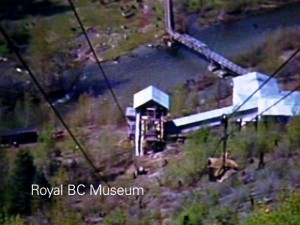
"The town of Ymir and the nearby Yankee Girl gold mine. [COLOUR:] Mining concentrator building (with aerial tramway) beside the Salmo River. Mine site, high on mountainside; buildings; small electric train of ore cars; dumping tailings on hillside; dumping ore into aerial tramway; tramway buckets descending very steep hillside to concentrator, and emptying into hopper there. B&W: interior shots (some dark): ore on conveyor belt; refining processes [cyanidation and flotation]; etc. COLOUR: bridge across river for ore cars. B&W: interior of assay office; staff with instruments, performing tests, etc. COLOUR: May Day celebrations: baseball game; rock-drilling contest; presentation of prizes; May Queen pageant and crowning; children maypole dancing." (BC Archives)
The extant reel concludes with footage from elsewhere in the Kootenay Lake Region (Kootenay Lake, Nelson and Kettle Falls), which seems unrelated to the Ymir and... title. This item was part of an apparent series assembled by Morrell under the overall title British Columbia Sketches. Since the series title precedes the item title as shown above, this film was described by the BC Archives as British Columbia Sketches : [reel 8].
"Edited film created by Frank L. Kreznar, an award winning amateur filmmaker, documents Slovenia, Croatia, Bosnia-Herzegovina, Vojvodina, and Serbia. Most of the footage is of countryside or mountainous areas although Kreznar depicts Zagreb, Croatia, and Belgrade, Serbia. The historic Petrovaradin Fortress in Vojvodina, Serbia, is only historic building filmed. The footage of Slovenia emphasizes agriculture, while the footage of Bosnia-Herzegovina includes scenic shots of mountains and waterfalls. Kreznar also shows traditional houses in the rural areas providing a contrast to modern Soviet construction such as Soviet-style apartment buildings. Shots of urban areas also include an emphasis on the lack of cars, high volumes of pedestrian traffic, and the popularity of public transportation. He depicts churches that are still being actively used while discussing the lack of Soviet suppression of religion in Yugoslavia, and he shows the existence of privately held business enterprises such as taxi services and cafés. He also mentions that the majority of Yugoslavian agriculture is under private, family control and that private businesses with five or less employees are allowed to exist. Kreznar discusses the impact of wars between Eastern and Western Europe on this territory, showing various war memorials throughout the film. The film ends with footage of hitchhikers – mainly from countries in Western Europe – attempting to travel through the country" via the Human Studies Film Archives, Smithsonian Museum.
Total Pages: 15